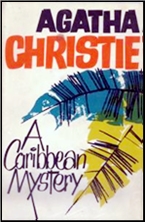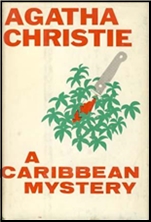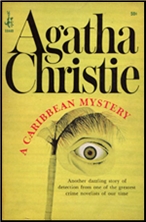Sat 21 Nov 2020
A 1001 Midnights Review: AGATHA CHRISTIE – A Caribbean Mystery.
Posted by Steve under 1001 Midnights , Reviews[5] Comments
by Susan Dunlap

AGATHA CHRISTIE – A Caribbean Mystery. Miss Marple #9. Collins Crime Club, UK, hardcover, 1964. Dodd Mead, US, hardcover, 1965. Pocket Book #50449, US, paperback, 1966. Reprinted many times in both hardcover and paperback. TV adaptations: (1) A Caribbean Mystery, US, TV movie, 1983 with Helen Hayes as Miss Marple. (2) Agatha Christie’s Miss Marple. BBC (Series 1, Episode 10), 1989 starring Joan Hickson as Miss Marple. (3) Agatha Christie’s Marple, BBC (Series 6, Episode 1) with Julia McKenzie as Miss Marple.
The appeal of Christie’s Miss Jane Marple books is their deceptive simplicity. They are quiet, full of thought and conversation. which is seldom interrupted by action. Miss Marple, elderly maiden lady of the village of St. Mary’s Mead, is considered an “old dear” or “old pussy” by the other characters. But in her many years of village life she has observed character, and pondered over the failings of her fellow villagers. “So many interesting human problems-giving rise to endless pleasurable speculation.” St. Mary’s Mead is a microcosm of the larger world outside; and her years of watching events there have honed Miss Marple’s perceptive faculties to a fine point.

This novel proves Miss Marple to be as acute while on holiday in the Caribbean as on her own turf. The manager of the Golden Palm Hotel where she is staying resembles a headwaiter from St. Mary’s Mead; another guest reminds her of a village barmaid; yet another is like Lady Caroline Wolfe, a local who committed suicide. Thus Miss Marple is able to relate the principles she has evolved in her native village to these new acquaintances.
In this tropical setting, Major Palgrave (you can cell by his name he’s not long for this world) chatters to Miss Marple, retelling his repertoire of tedious tales, including one of a man who killed two wives and escaped. “Do you want to see the picture of a murderer’?” he asks.

But as he is extracting it from his wallet, he sees someone over Miss Marple’s shoulder, turns purple, stuffs the picture back in his wallet – and is dead before the day is over. Only Miss Marple suspects murder. Far from St. Mary’s Mead, unaided by her usual friends, but armed with the discovery of similarities to her own villagers and their own – albeit simpler – intrigues, Miss Marple must unearth the truth.
Miss Marple sees her fellow characters as stereotypes – which indeed they are. Christie is as up front about that as she is in laying her clues, reminding her readers they are there, and daring them to outguess her which, after all, is the fun of a Christie novel.
———
Reprinted with permission from 1001 Midnights, edited by Bill Pronzini & Marcia Muller and published by The Battered Silicon Dispatch Box, 2007. Copyright © 1986, 2007 by the Pronzini-Muller Family Trust
November 21st, 2020 at 9:57 pm
II have enjoyed, more than once, all of the Joan Hickson Miss Marpole shows, principally The Body in the Library and The Mirror Cracked; almost equally the Geraldine McEwan episodes, but McEwan did not have the benefit of playing against, or with, John Castle as Dermot Craddock. After her retirement from the part and the business, I gave the series a pass. As for Helen hayes, I thought she was indifferent or miscast but the Caribean Mystery worked well enough, but not enough if you know what I mean.
November 21st, 2020 at 9:58 pm
Marple, not Marpole — although that has some charm?
November 21st, 2020 at 10:59 pm
By the McKenzie episodes they were straying pretty far afield from Christie. When Ian Fleming showed up, played as effeminate to boot, I was pretty sick of their games.
The real Marple, and Hickson is certainly the best of the lot however much fun Rutherford was, has always struck me as the toughest of Christie’s sleuths, emotionally and morally.
There is steel in more than Miss Marple’s knitting needles, and something much tougher in Christie and her view of crime and morality than might seem apparent at first gkance.
November 22nd, 2020 at 5:06 pm
Right. Christie is seen today mostly as a “cozy” writer, but not by those who’ve actually read what she wrote.
April 25th, 2022 at 5:38 am
[…] Cross-examining Crime, Fictionfan at FictionFan’s Book Reviews, Les Blatt at Classic Mysteries, Susan Dunlap at Mystery File, and John Harrison at Countdown John’s Christie […]